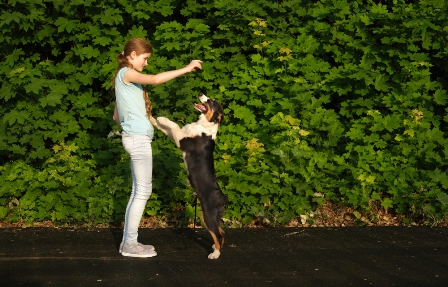Welcoming a new puppy into your home is an exciting and rewarding experience. As responsible pet owners, it’s essential to provide them with the guidance and training they need to become well-behaved, happy companions. Proper training sets the foundation for a strong bond between you and your furry friend. In this article, we’ll explore the step-by-step process of training a new puppy, from the basics to more advanced techniques.
1. Preparing for Puppy Training
Before diving into training, it’s crucial to prepare both your home and yourself. Puppy-proofing your living space ensures their safety and prevents any accidents. Remove hazards like small objects, electrical cords, and toxic plants that your curious pup might chew on or ingest. Additionally, gather essential supplies such as a collar, leash, food and water bowls, toys, and a comfortable bed.
2. Building a Strong Foundation
Establishing a Routine:
Puppies thrive on routines. Set consistent feeding, playtime, and potty schedules to help them understand what’s expected.
Socialization with People and Other Pets:
Introduce your puppy to various people, dogs, and environments. Early socialization contributes to a well-adjusted and confident adult dog.
3. Basic Commands and Obedience Training
Teaching your puppy basic commands is essential for their safety and your sanity. Using positive reinforcement, you can teach them commands like “sit,” “stay,” and “come.”

Teaching Sit, Stay, and Come:
Start with sit, as it’s relatively easy. Reward with treats and praise when they follow the command. Gradually move on to stay and come.
Using Positive Reinforcement:
Reward good behavior with treats, praise, and affection. This encourages your puppy to repeat desired actions.
4. Crate Training and Potty Training
Creating a Comfortable Crate Space:
Make the crate a cozy den by placing soft bedding and toys inside. Associate positive experiences with the crate to alleviate anxiety.
Consistent Potty Training Techniques:
Take your puppy outside frequently, especially after meals and naps. Praise and reward them for going potty outdoors.
5. Leash Training and Walking Etiquette
Introducing the Leash:
Let your puppy get accustomed to wearing a collar and leash indoors. Allow them to explore while wearing the leash before moving to outdoor walks.
Teaching Loose Leash Walking:
Encourage your puppy to walk beside you without pulling. Stop walking when they pull and resume when the leash is slack.
6. Addressing Common Behavioral Issues
Chewing, Biting, and Nipping:
Provide appropriate chew toys to redirect their chewing behavior. If they bite or nip, say “ouch” and withdraw attention to discourage this behavior.
Excessive Barking and Whining:
Identify the triggers for barking or whining and address them. Teach “quiet” as a command and reward them for stopping the noise.
7. Advanced Training Techniques
Teaching Tricks and Complex Commands:
Once your puppy masters the basics, challenge them with fun tricks like “roll over” or “shake hands.” Use the same positive reinforcement techniques.
Impulse Control and Focus:
Teach your puppy to control impulses, like not rushing through doors. Enhance their focus through games and exercises that require concentration.
8. Maintaining Training Consistency
Reinforcing Learned Behaviors:
Continue practicing commands regularly to prevent regression. Gradually reduce treat rewards but maintain verbal praise.
Adapting to Your Puppy’s Growth:
As your puppy grows, their needs and abilities change. Adjust training activities to match their age and development.
9. Positive Reinforcement vs. Punishment
The Importance of Positive Methods:
Positive reinforcement builds trust and encourages a strong bond. Avoid punishment-based training, as it can harm the relationship and lead to fear.
Avoiding Harmful Training Practices:
Physical punishment or yelling can damage your puppy’s confidence. Choose methods that motivate and empower your puppy.
10. The Role of Patience and Persistence
Embracing the Learning Process:
Remember that puppies learn at their own pace. Celebrate small victories and be patient when they struggle.
Celebrating Small Achievements:
Acknowledge your puppy’s progress, whether it’s learning a new command or displaying improved behavior.
11. Creating a Bond with Your Puppy
Building Trust and Affection:
Spend quality time with your puppy to build trust. Gently handle them, provide belly rubs, and engage in play.
Strengthening the Human-Canine Relationship:
A strong bond enhances communication and cooperation between you and your puppy.
12. Seeking Professional Help
Knowing When to Consult a Trainer:
If you encounter difficulties in training or behavior, consider seeking assistance from a professional dog trainer.
Choosing a Reputable Dog Trainer:
Research and choose a trainer with a positive approach and experience in addressing your specific challenges.
13. FAQs:
Here are answers to some frequently asked questions about How to Train a New Puppy
The first thing to teach your puppy is their name. Use treats and positive reinforcement when saying their name, so they associate it with something positive.
The best age to start training a puppy is around 8 to 12 weeks old. This is when they are most receptive to learning and socialization.
On the first night, it’s a good idea to have your puppy sleep in a cozy crate or a designated area in your bedroom. This helps them feel secure and reduces separation anxiety.
The time it takes for a dog to adjust to a new puppy varies. It can take a few days to a few weeks for them to become comfortable with each other’s presence.
A happy puppy will show signs of wagging its tail, relaxed body posture, playful behavior, and bright, alert eyes. They will also eat well and interact enthusiastically with you.
To discipline a biting puppy, use a firm “no” and withdraw attention when they bite. Provide appropriate chew toys and redirect their biting behavior towards those toys. Consistency is key to teaching them that biting is not acceptable.
Conclusion
Training a new puppy requires dedication, patience, and a positive attitude. As you embark on this journey, remember that your efforts will result in a well-mannered and happy companion for years to come. The bond you develop through training will be the foundation of a lifelong friendship filled with love and joy.